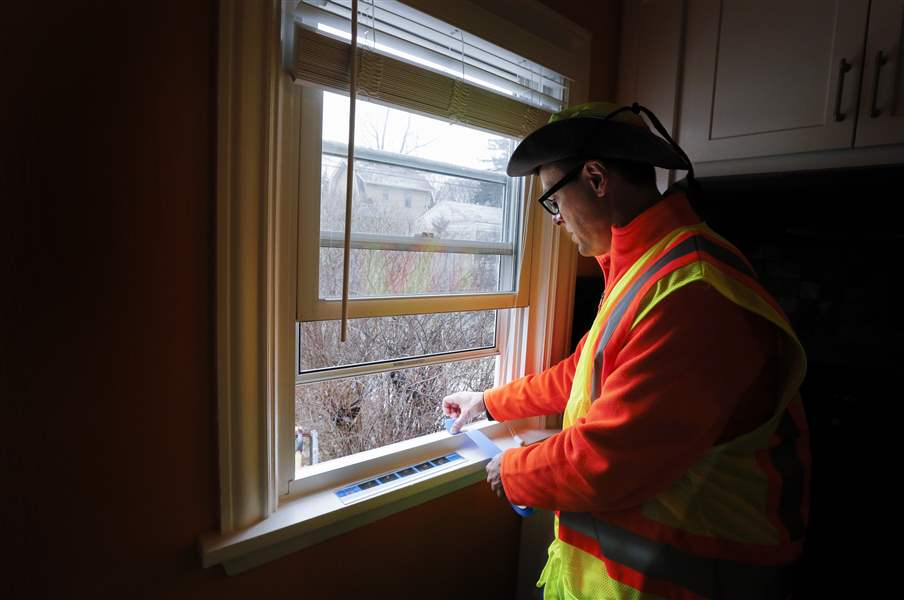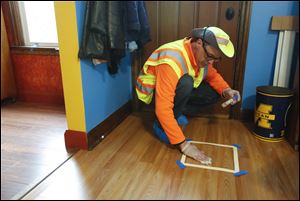
Toledo's lead-law deadline likely to be delayed
50,000 properties to be certified by Sept. 17; 39 done
3/19/2017
Anthony Weaver, a lead-clearance technician, tests for lead on a window. The deadline for testing and compliance is Sept. 17, but that date could change.
THE BLADE/ANDY MORRISON
Buy This Image
Inspectors are unlikely to get the lead out fast enough for landlords to be in compliance six months from now with the city’s lead-safe ordinance.
So far, 39 of the estimated 50,000 affected properties have the required certification. Inspectors would have to complete more than 8,000 inspections a month to meet the original compliance deadline — meaning the 55 inspectors registered with the health department would each have to complete more than five a day, every day, until Sept. 17.
Meanwhile, many landlords and inspectors are in a holding pattern, anticipating modifications to the law by Toledo City Council members.

Anthony Weaver, a lead-clearance technician, uses a dust wipe to check for lead in a home. Many inspectors and landlords hesitate to set up inspections because of looming changes.
They, along with Toledo-Lucas County Health Department officials, have stated the legislation, which passed in August and was enacted in September, will likely undergo changes before it arrives in its final form.
Council Tuesday postponed a committee of the whole meeting until April 11 to discuss the law.
The meeting was postponed for further discussion, said Councilman Larry Sykes. He said council is committed to working to improve the legislation so that it works for everyone, and the body will discuss topics such as moving the original deadline and working with property owners in historic neighborhoods.
“I don’t think we can get the properties inspected anywhere in that period of time,” Councilman Rob Ludeman said of the Sept. 17 date. “I think the deadline is going to have to be pushed forward no matter what.”
The law in its current form calls for rental properties with one to four units and day-care facilities to be inspected visually and tested for lead dust before the properties can be issued a lead-safe certificate. All properties subject to the law are supposed to be in compliance by the September date, although landlords with more than 10 properties can apply for a year extension.
Provisions criticized
While proponents say the law will decrease the risk of lead poisoning for children living in those rentals, some landlords and the real estate community have criticized the ordinance as a cumbersome and costly mandate on property owners.
A sticking point for many critics is the dust-wipe provision, which requires several surfaces around the unit to be swabbed for dust and the samples tested in a laboratory. Properties that fail the visual inspection or have samples that test too high for lead-dust concentrations are subject to cleaning and other improvements and then reinspection. A survey of inspectors shows the cost of inspection to be about $300 per unit, according to health department officials.
VIDEO: Lead inspectors in Toledo
Properties that pass on the first inspection are issued a six-year certificate. Those that fail but pass after reinspection receive a three-year certificate. Rental properties that have undergone lead abatement can apply for a 20-year certificate.
Mr. Ludeman said he anticipates changes to the law, referring back to the version of the legislation he proposed, which called for a visual inspection first and dust-swipe tests only if the property fails the visual check. As for the slow trickle of landlords scheduling appointments, he too cited the weather, as well as skepticism of the law’s future.
“When it was passed, no one ever believed [all properties] could be inspected in a year period of time,” he said. “I think that’s why a lot of landlords said, ‘Go ahead and pass it, you’re not going to get me, not even in five years. The honest and good landlords, most agree with the lead issue, but make it less expensive and so that we don’t have a time constraint that is going to put us under the gun.”
Mr. Ludeman said he owns two houses subject to the law and has not set up inspections for either, citing the weather as a primary factor in not cleaning and updating them before the inspection.
“We understand that, based on some experience in implementing the ordinance that certain changes are necessary,” said Bob Cole, who is on the executive committee of the Toledo Lead Poisoning Prevention Coalition, which was a major driver in getting the legislation in front of council. “We’re willing to work with city council, the health department, and landlords.”
Keeping the dust wipes in the law is essential, Mr. Cole said, but he added the executive committee is supportive of phasing in the ordinance in a targeted way: first focusing on properties in high-risk census tracts where children are more likely to be poisoned based on socioeconomic and public health data.
Harry Schmitz owns several rental properties subject to the law, although only one has been inspected and certified. The East Toledo property, which is more than 100 years old, passed a visual inspection but failed the dust-wipe test in one location, he said. He cleaned the area and had it retested, and he now holds a three-year lead safe certificate.
No pressure ... yet
Mr. Schmitz said he is hesitant to continue with the rest of his properties knowing the law might be tweaked. He would like to see the dust-wipe provision eliminated as well as the portion that testing happens in between tenants, when the property is vacant.
Mr. Schmitz also has several theories as to why compliance has been slow. One is the weather, as winter temperatures prevent owners from completing any required outdoor painting. Mr. Schmitz said he was skeptical that landlords feel pressure to meet the original deadline as well as the $50-a-day fine for being out of compliance after the deadline.
“I think the majority of people think, ‘There is no way it’s going to happen, let’s sit back and see what happens,’” he said. “Are they going to fine 50,000 different units? I don’t know.”
He added many landlords don’t know that this is happening, and the ones who do are waiting and watching.
“I did one [of my properties], and now I am holding back because who is going to do anything when there are changes happening?” he asked.
Mary Bennett, who owns four rental properties in the Old West End, said she is most concerned about the effects for landlords in the city’s historic districts who by law can’t do major modifications to the homes without approval.
“If we could have them vinyl-sided like the rest of Toledo it wouldn’t be so bad, but for us it’s a tall order,” she said. She has not set up inspections because she spent the winter making improvements in the basements of the homes and could not do outside work.
VIDEO: Blade Briefing, Lauren Lindstrom on Toledo’s lead ordinance
Time concerns
Josh Niese, who oversees the lead program for the health department, said he’s heard all of these concerns from landlords and said the health department is addressing them.
Mr. Niese said one of the biggest concerns is the time frame imposed on compliance. Keeping the dust-wipe provision in the law is essential, he said, echoing public comments by Health Commissioner Eric Zgodzinski earlier this year.
“We’re a firm believer with enough time and enough education that it will absolutely be feasible,” he said of the law.
Health-department officials were tasked with enforcing this law with no infrastructure or extra funding, he said. The department set up a curriculum to train local lead inspectors and is in the process of writing and disseminating educational information for tenants and landlords.
“The last six months, every effort has been to do what we can to build the infrastructure to make this happen,” Mr. Niese said.
“Someone can look at our current process and say I’ve only got 55 people who can do the inspection, and we’ve only got 39 properties, but what that says to us is that we’ve created a foundation for something to start. We’ve created an infrastructure that’s working.”
They have discussed putting information about the ordinance in a water bill at some point, but nothing has been scheduled because of anticipated changes by council, he said.
The department is also working on a series of informational videos, which are online at lucascountyhealth.com.
“For seven months the clock has been ticking, but seven months ago there wasn’t any way for someone who wanted to comply could comply,” he said. “The infrastructure wasn’t there. That’s no longer the case now. You have those tools available to comply.”
Anthony Weaver took the health department’s class and is now registered as a lead clearance technician. He said things are moving in the right direction, though winter and confusion over the specifics of the law haven’t helped compliance.
“I do think the word is getting out,” he said. “After April 11, I think it’s really important that [city council] is finally going to tell landlords what they are supposed to do and where we go from here, getting those small changes made so we know how to move forward.
“I don’t know if we [as inspectors] can do much more until city council makes a decision,” he said. “We’re answering questions as best we can.”
Contact Lauren Lindstrom at llindstrom@theblade.com, 419-724-6154, or on Twitter @lelindstrom.